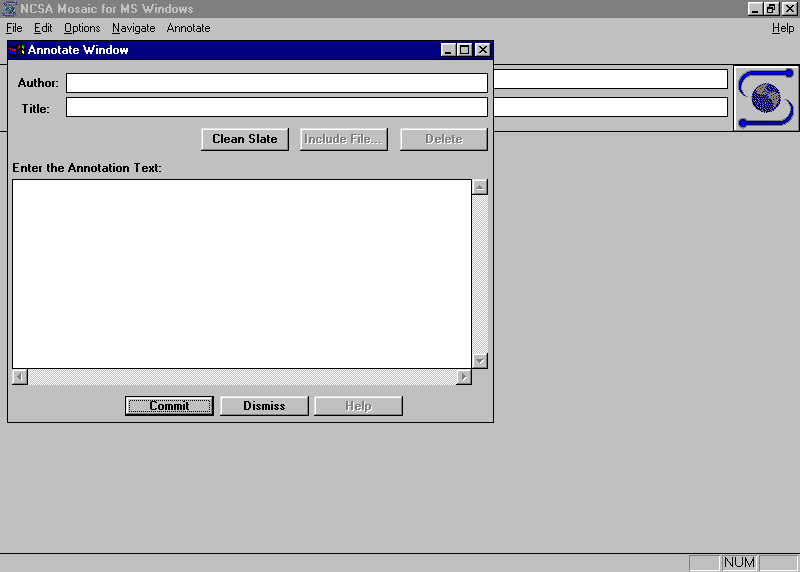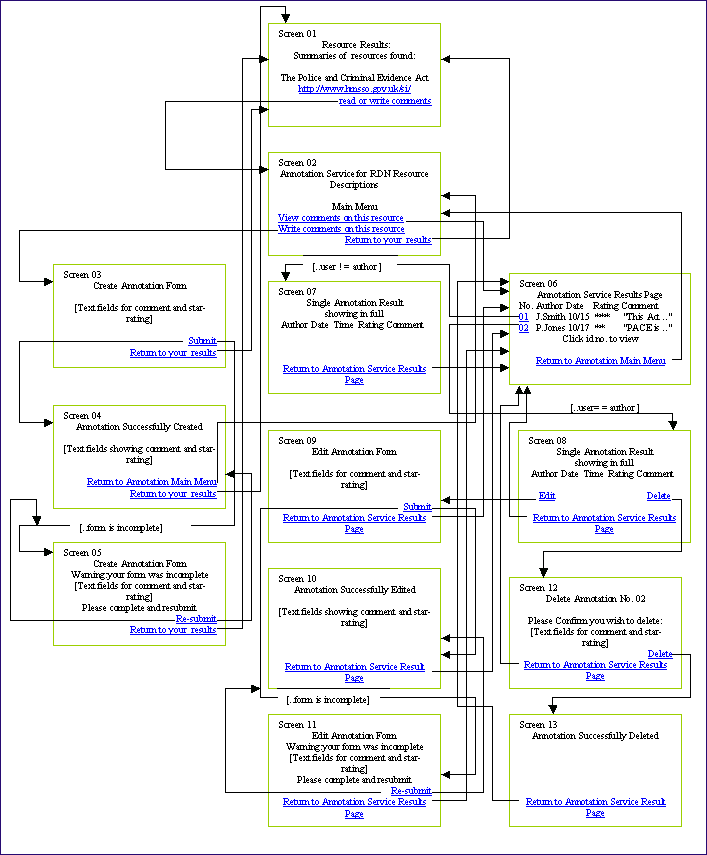8,037 Matching Annotations
- Aug 2022
-
www.youtube.com www.youtube.com
-
-
soundcloud.com soundcloud.com
-
www.w3.org www.w3.org
Tags
Annotators
URL
-
-
nodejs.org nodejs.org
Tags
Annotators
URL
-
-
www.mementoweb.org www.mementoweb.org
Tags
Annotators
URL
-
-
www.w3.org www.w3.org
-
Annotator Requirements Annotation client should be able to: handle targets for both canonical document URLs and versioned document URLs associate annotation with their specific versioned document URL establish whether the document server supports the Memento protocol, or whether there is an appropriate third-party Memento server (such as the Wayback Machine) which does store previous versions of the document negotiate datetimes with the Memento server for retrieving the correct version of the document in the case of a third-party Memento server, request that the service make a snapshot of the document at the time of annotation
Tags
Annotators
URL
-
-
webconcepts.info webconcepts.info
Tags
Annotators
URL
-
-
www.arkko.com www.arkko.com
Tags
Annotators
URL
-
-
www.bortzmeyer.org www.bortzmeyer.org
Tags
Annotators
URL
-
-
datatracker.ietf.org datatracker.ietf.orgrfc59881
Tags
Annotators
URL
-
-
getpocket.com getpocket.com
-
-
www.programmableweb.com www.programmableweb.comPocket1
Tags
Annotators
URL
-
-
www.kontxt.io www.kontxt.ioKontxt1
-
-
www.w3.org www.w3.org
Tags
Annotators
URL
-
-
www.prismstandard.org www.prismstandard.org
Tags
Annotators
URL
-
-
www.bnf.fr www.bnf.fr
Tags
Annotators
URL
-
-
github.com github.com
Tags
Annotators
URL
-
-
eoxc.github.io eoxc.github.io
Tags
Annotators
URL
-
-
stackoverflow.com stackoverflow.com
-
```js // Fetch and return the promise with the abort controller as controller property function fetchWithController(input, init) { // create the controller let controller = new AbortController() // use the signal to hookup the controller to the fetch request let signal = controller.signal // extend arguments init = Object.assign({signal}, init) // call the fetch request let promise = fetch(input, init) // attach the controller promise.controller = controller return promise }
// and then replace a normal fetch with
let promise = fetchWithController('/') promise.controller.abort() ```
-
-
addons.thunderbird.net addons.thunderbird.netSieve1
-
www.mulberrymail.com www.mulberrymail.com
-
www.mulberrymail.com www.mulberrymail.com
Tags
Annotators
URL
-
-
www.bortzmeyer.org www.bortzmeyer.org
-
datatracker.ietf.org datatracker.ietf.org
-
hypothes.is hypothes.is
-
-
rmolinamir.github.io rmolinamir.github.io
Tags
Annotators
URL
-
-
datacite-metadata-schema.readthedocs.io datacite-metadata-schema.readthedocs.io
-
blog.flycode.com blog.flycode.com
-
icannwiki.org icannwiki.org
-
-
docs.oasis-open.org docs.oasis-open.org
-
docs.oasis-open.org docs.oasis-open.org
-
blog.prototypr.io blog.prototypr.io
-
superavi.com superavi.com
-
-
www.dublincore.org www.dublincore.org
-
www.dublincore.org www.dublincore.org
Tags
Annotators
URL
-
-
www.dublincore.org www.dublincore.org
Tags
Annotators
URL
-
-
www.dublincore.org www.dublincore.org
-
www.dublincore.org www.dublincore.org
-
hypothes.is hypothes.is
-
-
webkit.org webkit.org
-
```html
<figure> <figcaption>Maggie loves being outside off-leash.</figcaption>
</figure>
<figcaption>Maggie loves being outside off-leash.</figcaption>
</figure>
css figure:has(figcaption) { background: white; padding: 0.6rem; } ```
-
-
stackoverflow.com stackoverflow.com
-
/* global var1, var2 */
-
-
blog.logrocket.com blog.logrocket.com
-
Sanitizing iframes
```html
<iframe id="webpage"></iframe><br/> <button onclick="sanitize()">Sanitize</button>
<script> function sanitize() { // Create a sanitizer object with the default config const sanitizer = new Sanitizer(); // Find the iframe node const iframe = document.getElementById('webpage'); // Sanitize the iframe's document node const sanitizedFrameNodes = sanitizer.sanitize(iframe.contentWindow.document); iframe.replaceChildren(sanitizeFrameNodes); } </script>```
-
-
css-tricks.com css-tricks.com
Tags
Annotators
URL
-
-
www.smashingmagazine.com www.smashingmagazine.com
-
www.w3.org www.w3.org
-
-
developer.mozilla.org developer.mozilla.org
-
www.youtube.com www.youtube.com
-
www.france.tv www.france.tvThalassa1
-
www.allocine.fr www.allocine.frHPI1
-
hypothes.is hypothes.is
Tags
Annotators
URL
-
-
-
In line with the much-requested (and long-longed-for) feature of highlights in different colors (an exhaustive list given in #198), I would like to suggest allowing (automatic) coloring of highlights based on tags with designated patterns (like code:critiques, code:non-ergodicity in psychology, etc.), or alternatively, all tags (i.e., without specific patterns).
-
-
-
Made a quick strawman mockup of what it could look like from the editor side:

-
-
www.slideshare.net www.slideshare.net
-
handled5 what the receiver does with the content is (wisely) out of scope suggestions for two patterns: reply: specify atom thr:in-reply- to mention: include rel="mentioned"
```xml
<entry xmlns='http://www.w3.org/2005/Atom'> <id>tag:example.com,2009:cmt-0.44775718</id> <author> <name>test@example.com</name <uri>bob@example.com</uri> </author> <thr:in-reply-to xmlns:thr='http://purl.org/syndication/thread/1.0' ref='tag:blogger.com,1999:blog-893591374313312737.post-3861663258538857954'> tag:blogger.com,1999:blog-893591374313312737.post-3861663258538857954</thr:in-reply-to> <content>Salmon swim upstream!</content> <title>Salmon swim upstream!</title> <updated>2009-12-18T20:04:03Z</updated> </entry> ```
-
-
Tags
Annotators
URL
-
-
daily-dev-tips.com daily-dev-tips.com
-
And in our case, we want it to keep track of our storage object. So let's also create a usePeristentContext hook.
```js import { useMutation, useQuery, useQueryClient } from 'react-query';
export default function usePersistentContext(key) { const queryClient = useQueryClient();
const { data } = useQuery(key, () => localStorage.getItem(key));
const { mutateAsync: setValue } = useMutation( (value) => localStorage.setItem(key, value), { onMutate: (mutatedData) => { const current = data; queryClient.setQueryData(key, mutatedData); return current; }, onError: (_, __, rollback) => { queryClient.setQueryData(key, rollback); }, } );
return [data, setValue]; } ```
js function SetContext() { const [value, setValue] = usePersistentContext('item_context'); return ( <button onClick={() => setValue(value === 'on' ? 'off' : 'on')}> Click me {value} </button> ); }
-
-
chromium.googlesource.com chromium.googlesource.com
-
web.dev web.dev
-
-
luhuangmsft.github.io luhuangmsft.github.io
-
-
mandymsft.github.io mandymsft.github.ioHello!1
-
-
techcommunity.microsoft.com techcommunity.microsoft.com
-
www.emerald.com www.emerald.com
-
www.sciencedirect.com www.sciencedirect.com
-
www.youtube.com www.youtube.com
-
-
www.webdesignmuseum.org www.webdesignmuseum.org
-
www.youtube.com www.youtube.com
-
-
www.youtube.com www.youtube.com
-
-
Tags
Annotators
URL
-
-
www.desy.de www.desy.de
Tags
Annotators
URL
-
-
www.w3.org www.w3.org
-
docs.github.com docs.github.com
-
-
-
No extra re-renders
-
-
attardi.org attardi.org
Tags
Annotators
URL
-
-
annotator.apache.org annotator.apache.org
Tags
Annotators
URL
-
-
www.w3.org www.w3.org
Tags
Annotators
URL
-
-
hypothes.is hypothes.is
-
-
www.openannotation.org www.openannotation.org
Tags
Annotators
URL
-
-
www.openannotation.org www.openannotation.org
Tags
Annotators
URL
-
-
tobyshorin.github.io tobyshorin.github.io
-
subpixel.space subpixel.space
-
www.cognexus.org www.cognexus.org
-
www.nngroup.com www.nngroup.com
-
code.tutsplus.com code.tutsplus.com
-
www.elsevier.com www.elsevier.com
-
www.ariadne.ac.uk www.ariadne.ac.uk
Tags
Annotators
URL
-
-
tomcritchlow.com tomcritchlow.com
Tags
Annotators
URL
-
-
blog.prototypr.io blog.prototypr.io
-
developer.mozilla.org developer.mozilla.org
-
developer.mozilla.org developer.mozilla.org
-
web.dev web.dev
-
PWAs as URL Handlers was part of the capabilities project and support for the experimental url_handlers manifest member, documented below, is being phased out. The url_handlers manifest member is being replaced by the new handle_links manifest member, which is currently being standardized and implemented.
Tags
Annotators
URL
-
-
-
-
chromestatus.com chromestatus.com
-
Implementation status: No longer pursuing
Tags
Annotators
URL
-
-
developer.mozilla.org developer.mozilla.org
-
The setHTML() method of the Element interface is used to parse and sanitize a string of HTML and then insert it into the DOM as a subtree of the element. It should be used instead of Element.innerHTML for inserting untrusted strings of HTML into an element.
```js const unsanitized_string = "abc <script>alert(1)<" + "/script> def"; // Unsanitized string of HTML const sanitizer1 = new Sanitizer(); // Default sanitizer;
// Get the Element with id "target" and set it with the sanitized string. document.getElementById("target").setHTML(unsanitized_string, {sanitizer: sanitizer1});
// Result (as a string): "abc def" ```
-
-
twitter.com twitter.com
-
twitter.com twitter.com
-
github.com github.com
-
structurae.net structurae.net
Tags
Annotators
URL
-
-
structurae.net structurae.net
-
xmpp.org xmpp.org
-
-
wicg.github.io wicg.github.io
Tags
Annotators
URL
-
-
developer.mozilla.org developer.mozilla.org
-
-
-
chromestatus.com chromestatus.com
-
-
In addition to resources annotations, tags, highlights and comments, it would be nice to store our own personal notes on Hypothesis.
@chrisaldrich @dwhly @gyuri @jeremydean @judell @katelyn @robertknight @tilgovi
Tags
Annotators
URL
-
-
xml.coverpages.org xml.coverpages.org
Tags
Annotators
URL
-
-
www.w3.org www.w3.org
Tags
Annotators
URL
-
-
deadspecs.work deadspecs.work
-
www.youtube.com www.youtube.com
-
-
javascript.info javascript.info
Tags
Annotators
URL
-
-
www.joshwcomeau.com www.joshwcomeau.com
Tags
Annotators
URL
-
-
beta.reactjs.org beta.reactjs.org
-
-
paul.kinlan.me paul.kinlan.me
Tags
Annotators
URL
-
-
w3c.github.io w3c.github.io
Tags
Annotators
URL
-
-
w3c.github.io w3c.github.io
-
-
wicg.github.io wicg.github.io
-
-
webmasters.stackexchange.com webmasters.stackexchange.com
-
datatracker.ietf.org datatracker.ietf.org
Tags
Annotators
URL
-
-
javascript.info javascript.infoBlob1
-
-
imagekit.io imagekit.io
Tags
Annotators
URL
-
-
developer.mozilla.org developer.mozilla.org
Tags
Annotators
URL
-
-
www.sitemaps.org www.sitemaps.org
Tags
Annotators
URL
-
-
wordpress.org wordpress.org
-
github.com github.com
-
www.w3.org www.w3.org
Tags
Annotators
URL
-
-
webmention.io webmention.io
-
-
kiko.io kiko.io
-
microformats.org microformats.org
Tags
Annotators
URL
-
-
www.w3.org www.w3.org
-
-
soundcloud.com soundcloud.com
-
www.w3.org www.w3.org
Tags
Annotators
URL
-
-
soundcloud.com soundcloud.com
-
soundcloud.com soundcloud.com
-
www.youtube.com www.youtube.com
-
Tags
Annotators
URL
-
-
-
-
iiif.io iiif.io
Tags
Annotators
URL
-
-
hypothes.is hypothes.is
Tags
Annotators
URL
-
-
tech.groww.in tech.groww.in
-
developer.mozilla.org developer.mozilla.org
-
levelup.gitconnected.com levelup.gitconnected.com
-
turn regular custom hook into a singleton custom hook
-
-
stackblitz.com stackblitz.com
Tags
Annotators
URL
-
-
gist.github.com gist.github.com
-
golb.hplar.ch golb.hplar.ch
Tags
Annotators
URL
-
-
golb.hplar.ch golb.hplar.ch
-
www.zhenghao.io www.zhenghao.io
-
-
hypothes.is hypothes.is
-
-
github.github.com github.github.com
-
-
hypercore-protocol.org hypercore-protocol.org
Tags
Annotators
URL
-
-
bimigroup.org bimigroup.org
-
-
support.google.com support.google.com
-
Example BIMI records
This is an example BIMI record that includes a VMC. This record includes 2 example URLs :
- URL for your brand logo SVG file on your public web server.
- URL for your VMC on your public web server. Gmail requires a VMC to display BIMI logos in the Gmail inbox
. v=BIMI1;l=https://images.solarmora.com/brand/bimi-logo.svg;a=https://images.solarmora.com/brand/certificate.pem
This is an example BIMI record that doesn’t use a VMC. Make sure to replace the example URL with the URL for your own SVG file location.
-
-
www.w3.org www.w3.org
Tags
Annotators
URL
-
-
www.w3.org www.w3.org



